New Kahr CW9
A concealable sure-shooting mini-9 that won’t bust a budget!
Complete Book of Handguns 2006, p.16-19
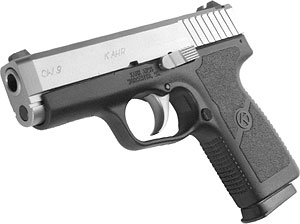 The Kahr CW9 has a simple, clean, familiar silh ouette.
The Kahr CW9 has a simple, clean, familiar silh ouette.
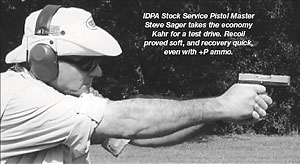 IDPA Stock Service Pistol Master Steve Sager takes the economy Kahr for a test drive. Recoil proved soft, and recovery quick, even with +P ammo.
IDPA Stock Service Pistol Master Steve Sager takes the economy Kahr for a test drive. Recoil proved soft, and recovery quick, even with +P ammo.

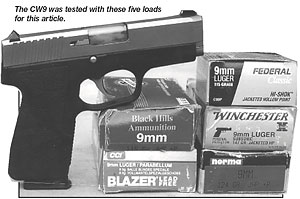 The CW9 was tested with these five loads for this article.
The CW9 was tested with these five loads for this article.The Kahr pistols have been among us for a decade now. They've made a lot of friends. Available in a myriad of models now, they've become extremely popular as off-duty guns (they're authorized for that on NYPD, among other departments), and I see a lot of them in the hands of students who come to my Lethal Force Institute classes with CCW cards, i.e., concealed carry permits.
It is from that last terminology that we get the name of the latest Kahr, the CW9. Concealed Weapons permit holders clamored for a low-priced version of this popular gun, and the first of the economy style is a 9mm, hence the designation of the pistol.
Justin Moon, the head of Kahr Arms, has been remarkably attentive to constructive criticism. People said, "It's a great 9mm, but we want something more powerful." Justin responded by offering Kahrs in .40. "It's a great compact, but can't you make it as a sub-compact?" As a result, the MK9 and MK40 were born, letters stand for "Micro-Kahr."
"It's a beautiful little gun, but it's heavy for its size," people complained. Kahr Arms answered with their P-seri es with polymer frames. Dramatically lighter, but still very controllable in recoil.
"Surely, if you could make it smaller and then you could make it lighter, you can make it lighter and smaller," said the marketplace. With an almost audible sigh, Kahr came out with the little, light polymer frame PM series of subcompacts.
"It shoots so well, can't we have a bigger one for target practice?" The company offered the T9 in all stainless, longer barrel and slide, and longer frame, which took a proportionally longer magazine with one more 9mm round.
"But it still costs money," a demanding public wailed. Which is why we now have the "economy grade" Kahr CW9.
Gun Details
We looked immediately for where the corners have been cut on our test CW9. Some evidence of that is immediately visible.
First, we observe the absence of a s p a re magazine. Many folks who are just getting into responsible concealed carry don't pack spare ammunition on their person. As soon as they wake up and start doing that, they can get all the Kahr magazines they want for a bit under $30 apiece, a fair price. In testing, I found that the magazines from my older K9 (all steel) and P9 (polymer frame) standard size 9mm Kahrs fit the CW9 just fine, and more important, worked fine too.
The front sight is plastic instead of steel. The front sight is pinned in place where on the standard-line Kahrs, it's dovetailed. The rear is the standard steel dovetail style.
Where the conventional Kahr's front slide edges are polished round and "melted" at the factory, the company has ingeniously eliminated this operation by machining flats that angle toward the muzzle. Some of the "sculpting" that is seen on the stand ard K9 or P9 is also absent. The result is a pistol that looks flatter and plainer. Seen in profile from above, the new economy machining sort of creates a flat-tipped "chisel point" profile.
One other complaint to which Justin Moon listened, and I appreciate it, because I was one of those who shouted it the loudest, was the rounding of the sharp edge of the slide stop on the Pseries pistols. You didn't notice it on the standard K9 and K40, because the rubbery Hogue grips that came on the gun shielded the firing thumb from the edge in question. However, the flat sides of the polymer frame guns made it prominent. This rounding is now present on the CW9, but those who hold it as I do will be back in the land of comfort.
Your standard line Kahr with stainless upper has a bead-blasted look to its matte finish. The CW9 has a finish that's a little bit rougher. The lettering on the slide is in simple, straight lines, which look a little shallower than the deeper, blockier cuts of the letters and numerals that appear on the slide on other Kahrs.
And that's it. The smooth, sweet double-action-only pull is still there. So is the ingenious striker fired design, and everything else Kahr fans have come to like about these little pistols. What you're getting is a gun that doesn't look quite so classy, but works just the same, for $143 less.
No wonder Kahr Arms calls it "value pricing."
Range Time
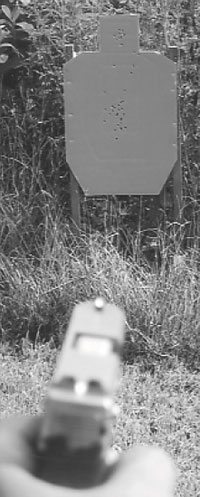 CW9 exhibited good pointing characteristics. Head-shots on target are from aimed fire.
CW9 exhibited good pointing characteristics. Head-shots on target are from aimed fire.
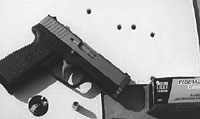 Though not as accurate as some other rounds in this test, Federal 9BP usually shoots tight in Kahrs and still kept all 5 rounds on the head at 25 yards. (5th hole is visible by ammo box.)
Though not as accurate as some other rounds in this test, Federal 9BP usually shoots tight in Kahrs and still kept all 5 rounds on the head at 25 yards. (5th hole is visible by ammo box.)
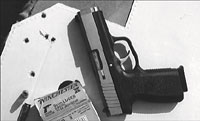 Low shot was 1st, hand cycled round from this otherwise accurate Winchester 147gr subsonic JHP at 25 yards with CW9. Note group location: high left of Shoot-N-C aiming dot.
Low shot was 1st, hand cycled round from this otherwise accurate Winchester 147gr subsonic JHP at 25 yards with CW9. Note group location: high left of Shoot-N-C aiming dot.
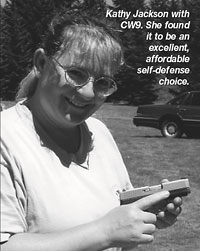 Kathy Jackson with CW9. She found it to be an excellent, affordable self-defense choice.
Kathy Jackson with CW9. She found it to be an excellent, affordable self-defense choice.
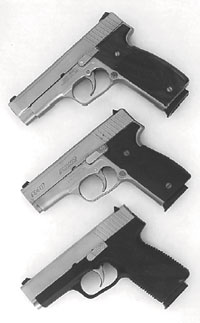 Top, Kahr T9, the largest pistol in the series. Center, the rugged, reliable standard size K40 in all-stainless construction. Bottom, CW9, standard size with polymer frame.
Top, Kahr T9, the largest pistol in the series. Center, the rugged, reliable standard size K40 in all-stainless construction. Bottom, CW9, standard size with polymer frame.I selected five loads covering the most popular bullet weights. I made sure to include among them Federal Classic 9BP, that company's exquisitely accurate 115-grain JHP, and Winchester's subsonic 147-grain JHP, a descendant of that maker's OSM (Olin Super Match) load, which is generally as accurate as it sounds. In the past, one or the other of these two loads had most often proven the single most accurate in my tests of Kahr 9mm pistols, usually the Federal. This time around, though, I was in for a surprise.
All shooting was done at 25 yards, f rom an impromptu handheld bench rest position. Each time, the first cartridge was hand-cycled into the firing chamber. The single best group came from a hot load, the Black Hills 115- grain +P, which uses the excellent Gold Dot bullet. All five shots, including the slightly errant first one, formed a group that measured 2.31 inches, center to center. Excluding that first shot, the measurement would have been only 1.44 inches. And, showing great cons istency, the best three of those were only 1.38 inches apart.
Long ago, Justin Moon told me that his research had indicated that very fast 115-grain bullets seemed to be the optimum loads for the short barrel 9mm, and he had designed his guns accordingly to handle such rounds. That's clearly evident here.
That said, he also did his design work when the craze for the 147-grain subsonic 9mm JHP was at its height. He made sure the guns would work with those, too. The Winchester 147- grain subsonic was next in the accuracy testing with a group that stretched to 3.25 inches. The best three shots, a measurement that factors out enough human error (if no called flyers are included) to be a good predictor of a given handgun's pure mechanical accuracy potential, was a tight 1.44 inches.
The other three rounds I tried were Norma's top quality Diamond line 124- grain +P JHP, the Federal 9BP load discussed above, and CCI Blazer Lead-Free, the kind of load that is increasingly demanded for training on some indoor ranges these days.
Once the first hand-chambered shot was factored out, all but the lead-free easily met the standard of 4 inches at 25 yards. The Norma round put its next four shots into 2.75 inches, its best three of 2.69 inches. The Federal 115-grain stand a rd velocity JHP planted its next four shots into 3.62 inches, and its best three into 2 inches even.
The lead-free stuff was all over the place. Frankly, I don't blame the gun for this. I rarely see good accuracy with lead - free primers. We actually had a couple of hangfires with this stuff. Not the hissÅcbang of the old-time black powder guns that they warn you about in hunter safety classes, but a quick click-bang. Perhaps this particular box of ammo had been in storage too long. Nonetheless, with ignition that erratic, you can't expect good accuracy. I've come to see ammo with lead-free primers as nothing m o re than a necessary evil.
when my friend and colleague Walt Rauch gave his excellent review of the CW9 in the September, 2005 edition of Combat Handguns magazine, he noted, "The CW9 did not like any of the brands of the non-toxic or frangible ammunition with groups opening up to 5 inches." My experience confirmed Walt's.
Several hundred rounds went through the test CW9, fired by numerous shooters during the course of this test. Three hundred or so of these shots were launched by the hands of first-time female shooters in an introductory class taught by Herman Gunter III, one of the most accomplished firearms instructors I know.
Kahr Arms, let it be said, is one of the very few companies that comes right out and says you should fire a couple hund red rounds through their pistols to break them in before you carry them to protect human life. This isn't a Kahr gun thing, it's a Kahr responsibility thing. I have preached for years that you shouldn't trust any firearm, revolver or auto or anything else, until 200 rounds of the carry ammo have gone through the carry pistol and its carry magazines with zero malfunctions.
The 200-round break-in period is analogous to the first 500 miles on a new car. It gives the parts a chance to "seat" with one another, to "wear in," to become the sum of their parts that whole machines are supposed to be. During those first 200 rounds, which occurred in Herman's classes, there were three malfunctions. All were failures to completely go into battery.
"I was watching those ladies when they shot," Herman told me later. "Every single one of them had Åebroken their wrist' at the time they fired the shot that caused the stoppage." To break the wrist means to relax it at the time the pistol fires. The slide of a semiautomatic pistol needs to run hard against the abutment of a rigidly held frame if the extractor and ejector are to do their part, and if the slide is to have enough power to fully chamber the next live round after the last spent casing has been extracted and ejected. The limp wrist is a famous, and infamous, cause of malfunctions in semiautomatic pistols.
Bianchi Ranger
I have to confess, I carried this pistol only for a single day. It was in a bellyband holster, the Bianchi Ranger, and loaded with the Black Hills +P. That test day was in the deep South in the hottest of August, and it rode inside a pair of shorts, covered by an untucked T-shirt.
First, there was no indication that anyone noticed I was armed as I went about town. That's what the Kahr's compact size, extremely slim profile , and rounded edges are all about. Second, there was no discomfort. That part of the pistol that wasn't encompassed by the holster was directly adjacent to bare skin. There was no chafing, no abrasion, no irritation, no problem at all.
One reason was that the sharp edge of the slide release lever was shielded by the Ranger bellyband's fabric, which was between me and that part of the pistol. If I owned this gun, I would very gently bevel the rear edges of the slide stop. I say that because it's an investment cast part, and the hollow inside comes rather close to the edges.
Shooting Impressions
Recoil, even with +P loads, is soft and manageable by anyone accustomed to handling a powerful handgun. When performing a reload, remember that it's a compact frame gun, so get the little finger of the firing hand out of the way when you slap in a fresh magazine or it will get pinched, as will happen with any other autopistol of this size during a speed reload.
The Kahr was built to be suitable for small hands. This is why its trigger reach is perfect for younger shooters, short - finge red males, and so very many women. My friend and graduate Kathy Jackson, a journalist and firearms instructor in Washington State, wrote glowingly of the Kahr CW9. When I chatted with her about it in person while at a class together in July 2005, she told me that she was impressed with how many women took to the Kahr pistol as if it was made for their hand, and how impressed she was with the CW9's accuracy and reliability. I mentioned earlier the women Herman Gunter had introduced to the handgun with the test CW9. They unanimously found it "user-friendly."
The opposite side of that card is that anyone with long fingers may find the trigger reach a little too short. My hand dimensions fit the profile for "average adult male," and I find that with the firing thumb curled down, my trigger finger occasionally hits the thumb and stops the pull. This is far more likely to happen if both my thumbs are curled down, the way I prefer to shoot a 1911 pistol, GLOCK, or revolver, since the right index finger is almost always blocked by the left thumb when firing the Kahr two-h and/right-hand.
The solution is simple, and I've shot the Kahr this way for almost 10 years. It's called the "LE grasp." In this case, "LE" stands not for "law enforcement," but for "Leatham/Enos." Rob Leatham and Brian Enos, superstars of practical shooting who rose in tandem and practiced together, developed a grasp where the thumbs were straight, and the thumb of the firing hand rested in line with the base of the thumb of the support hand.
Many people abuse this technique and let their thumbs press against the slide, but in the original technique, the firing thumb is completely clear of the slide. When applied to a Kahr, this keeps the right-handed shooter's firing thumb away from the sharp-edged slide stop. It will also keep that thumb from riding the slide stop and preventing the slide fro m locking open at the last shot, as it was intended to do.
Finally, the gun shot a little high and a lot left of point-of-aim. If I was going to keep it, since I can live with "a little high" more easily than I can with "a lot left," I would see about drifting the dovetailed rear sight.
Summary
Walt Rauch compared the CW9 vis-àvis the standard Kahr P9 with the Smith & Wesson Model 28 Highway Patrolman version of the fancy Model 27 .357 Magnum. A less finely finished version of the original, distinctly more affordable, and doing exactly the same job with a plain vanilla look-alike instead of deluxe outer trimmings. Walt was exactly right.
The Kahr CW9 is the good value they say it is. Check it out. You'll see what I mean. Frank Harris, VP of Sales and Marketing at Kahr, says the company is thinking about a .40 version sometime in 2006, but has no plans to offer a smaller CW9 or a version with night sights.
<< Go back to Previous Page